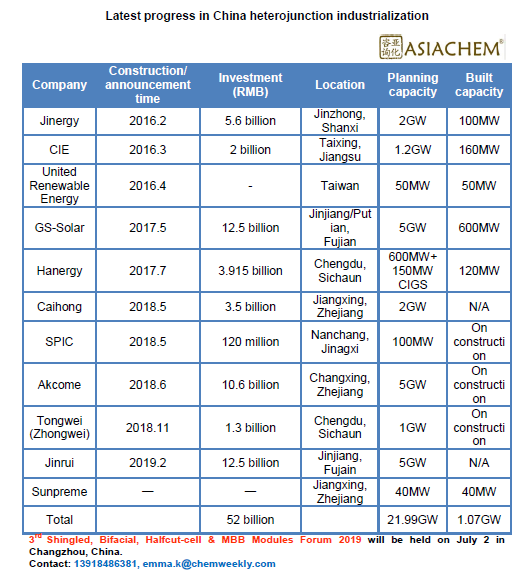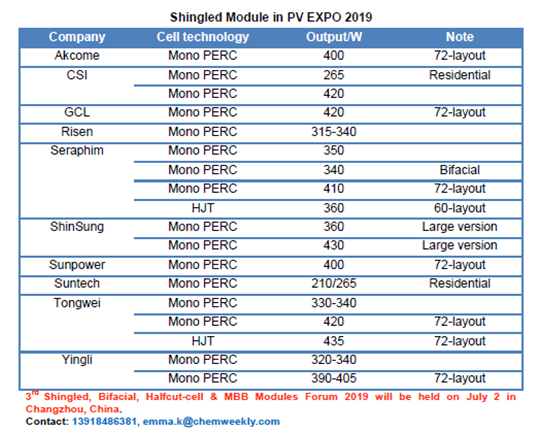In 2019, the grid parity project has become the focus of China's photovoltaic industry. It is imperative to reduce the Levelized Cost of Electricity (LCOE) by taking technological progress. Advanced module technologies are working together with high-efficiency solar cell technologies to increase PV system reliability and power generation efficiency, and reduce LCOE.
At present, heterojunction(HJT) cell and shingled module can be said to be the research hotspots of high-efficiency products at the cell end and module end respectively, and the ultra-efficient HJT modules encapsulated by shingled technology are widely concerned. In May 2018, new HJT shingled module developed by Tongwei Solar had a front-end power output of 442W and conversion efficiency of 21.7%. Since the bifacial rate of HJT is more than 90%, bifacial HJT shingled module is up to 500W under normal reflected light, which is the highest module power ever.
HJT: next generation ultra-efficient cell technology with the most industrial potential
Heterojunction (HJT), which is considered by the PV industry as the next generation of ultra-efficient cell technology that about to be mass-produced, has advantages of high conversion efficiency, simple manufacturing process, thin silicon wafer, low temperature coefficient, no LID, bifacial power generation, etc. At present, the highest R&D efficiency HJT cell has reached 26.6%, the mass production efficiency o is about 23%, and the space for efficiency improvement is huge.
At present, there are more than ten enterprises in the domestic layout HJT technology, mainly Jinergy, CIE, Hanergy, GS-Solar, Tongwei, Akcome, Caihong, SPIC, etc. Among them, Jinergy, CIE, Hanergy, GS-Solar have built the production line, and most of the scale is 100MW-level. Newcomers such as Tongwei, Akcome and Caihong have announced GW-level HJT capacity layout last year, currently most of the production line is under construction.
According to the statistics of ASIACHEM, from 2016 to the present, the total planned production capacity of China's heterogeneous projects is about 22GW, the total investment is as high as RMB 52 billion, and the actual built capacity is about 1GW. Most enterprises are still in the evaluation or pilot stage, and have not yet formed a large-scale development.

Shingled: revolutionary high-efficiency module encapsulating technology
Shingled module consisting of solar cells bonded by electrically conductive adhesive (ECA) to each other in a shingled manner, more cells can be placed in the same area compared to regular modules. It can reduce the resistance loss and hot spot effect, and the module power is increased by more than 10%.
Higher efficiency and lower loss, shingled technology will undoubtedly have a revolutionary impact on high-efficiency module encapsulating technology. Therefore, PV companies actively promote shingled technology R&D and mass production, domestic companies Seraphim, DZS Solar, Longi Solar, CSI, Tongwei, GCL, Akcome, Risen Solar, etc. have layout.
At PV EXPO 2019 in Tokyo, Japan, a number of companies exhibited shingled products, as shown in the table below. It can be seen that the shingled modules exhibited are mostly matched with mono PERC cells, and Seraphim and Tongwei also exhibit shingled modules with HJT cells. ASIACHEM research shows that the capacity of shingled modules in 2019 is expected to reach 10GW.

Source:PVInfoLink
HJT + Shingled: the best combination
The advantages of HJT technology are as described above, but it has certain difficulties to achieve large-scale development. On the one hand, HJT manufacturing cost is relatively high. On the other hand, if HJT is encapsulated by conventional packaging technology, the ribbon tensile force stability is difficult to control, and HJT cannot adopt high-temperature welding process, low temperature soldering process and material are required, so the encapsulating process is difficult.
If HJT cell is encapsulated in shingled technology, the above problems can be solved. The shingled technology adopts ECA connected cells in series, ECA has low temperature and flexible characteristics, and the no-ribbon design, which perfectly solves the problem of the ribbon tension stability and the low-temperature welding. In addition, HJT technology can adopt thinner silicon wafers. When conventional module packaging process is used, the soldering cells are difficult to be connected in series, and the HJT cell is easily damaged by mechanical stress and thermal stress. Shingled module does not use ribbon to connect cells, which reduces the fragmentation rate during the packaging process.
In terms of cost control, the first four items of HJT cell BOM cost are silicon wafers, silver pastes, target materials and texturing additives. Silver pastes account for an important proportion of HJT cell cost. At present, HJT cell for the shingled package has a finer busbar, and in the future, the TCO film can be used to cancel busbar, thereby saving more silver paste cost.
It can be seen that HJT cell is encapsulated in shingled technology, which contributes to the cost control and can solve the problems when HJT cell adopts the conventional packaging technology. At the same time, HJT shingled module can achieve higher power and effectively reduce LCOE. It is reported that Tongwei, Akcome, Risen, etc. have both laid out HJT technology and shingled technology.
Pain points of HJT shingled module
Although the future of HJT and shingled technology is bright, both of them still face certain challenges, and the development path is tortuous.
For HJT technology, the initial investment of equipment is higher, the cost of key auxiliary materials such as silicon wafer, silver paste and target material is higher, and the production line control and cell yield still need to be improved; for shingled technology, the initial investment in shingled special equipment and ECA make the module manufacturing cost high, and the automation level of shingled equipment needs to be further improved. It is also necessary to control the fragmentation rate in the slicing process and eliminate patent doubts.
It is believed that with the deepening of industrialization, HJT and shingled technology will be continuously improved, manufacturing cost will continue to decrease, and the future development prospects of HJT shingled module can be expected!
3rd Shingled, Paving, Bifacial, Halfcut-cell & MBB Modules Forum 2019 gold sponsored by Wuxi Lead Intelligent Equipment Co., Ltd. will be held on July 2-3 in Changzhou, Jiangsu, China. The upcoming conference will discuss global and China’s PV market outlook and module technology trends, technical advantages and investment returns of shingled, bifacial, halfcut-cell & MBB modules, ECA technology for shingled module, PV module intelligent manufacturing demonstration experience, shingled, bifacial, Halfcut-cell & MBB module key equipments, encapsulation materials and industrial production yield increase, bifacial module test standards and test equipment, other advanced technologies to increase module power, etc.